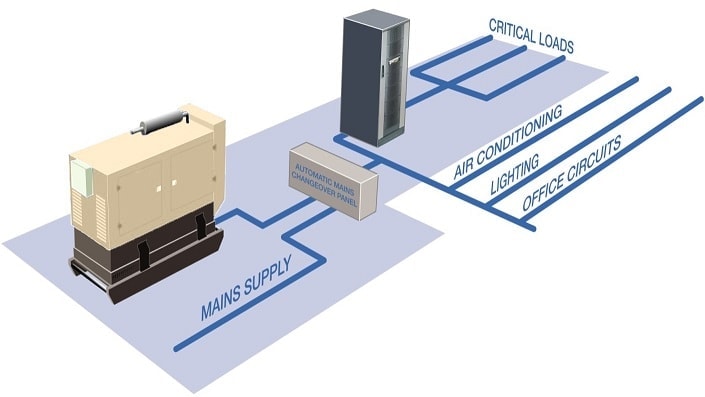For most modern businesses, Uninterruptible Power Supply (UPS) systems have become essential rather than optional. However, while demanding better protection than ever from their UPSs, users face unprecedented constraints on their budgets as well as pressure to ‘go green’. Fortunately, advances in semiconductor technology have ushered in modular UPS topology. This allows users to achieve the power protection they need more efficiently and cost-effectively than previously possible. KOHLER Uninterruptible Power Technical Sales Manager, Mike Elms, discusses why modular UPS are the right choice for today’s business applications.
The first commercial computers were something of a luxury as they automated tasks that had previously been performed manually – and could be performed manually again if the computer failed. By contrast many organisations now depend entirely on their ICT equipment’s uninterrupted availability to stay in business. Typically, they have 24/7 operations involving online transaction processing at national or international levels. Reverting to manual operation in the event of an extended ICT failure is no longer an option. The stakes are much higher, with more profound implications for the operating companies. Protection and security of the data held is equally as important.
This demand for ICT availability is, by extension, a demand for uninterrupted power availability – and it comes when the quality and reliability of the UK’s mains power supply has deteriorated, and is likely to deteriorate further. Uninterruptible power supply (UPS) protection has become essential. However it is also a time when budgets are under unprecedented pressure, and energy consumption must be minimised. As well as increasingly aggressive legislation, organisations must present green credentials to their customers, shareholders, employees and the media. So, the real UPS question concerns securing the best available power protection for minimal cost and energy penalties.
Modular topology and its benefits
Increasingly, modular UPS topology is becoming the answer for ICT operators facing these pressures.. The topology ultimately owes its existence to advances in the semiconductor industry. The monolithic double conversion on-line UPS systems that first appeared in the seventies were referred to as transformer based UPSs. They used a rectifier to convert incoming raw AC mains to a DC voltage, which was used to charge the UPS backup battery and to feed an inverter for conversion back to a clean AC output waveform. However an output transformer was needed to step up the inverter output to the level needed for the critical load.
By the mid nineties however, advances in power semiconductor technology and the arrival of the Insulated Gate Bipolar Transistor (IGBT) allowed a different, transformerless approach. In a typical design, an IGBT based DC converter boosts the rectifier output to a much higher level, allowing the inverter to directly produce an AC voltage sufficient to drive the critical load. The transformer was eliminated.
Many UPS advantages derive directly from transformerless design. These include greater efficiency, higher input power factor, lower input current harmonic distortion (THDi), reduced capital and operating costs, lower audible noise and enhanced battery life. But elimination of the transformer also yields very significant reductions in physical size and weight. For example a 120kVA system footprint shrinks from 1.32m2 to 0.53m2, while the weight reduces from 1200Kg to 370Kg. This scale of reduction and cost saving allows a different, modular configuration in which the critical load demand is met by a number of smaller UPSs operating in parallel rather than one large monolithic unit. This modular topology offers further improvements in efficiency as well as great benefits in resilience, availability, uptime and easier maintenance.
An example shows how users can best access these benefits. Suppose that a data centre has a load requirement of 120kVA, and because of its critical nature, a redundant UPS configuration is essential – i.e. a configuration that will continue to deliver power even if one UPS unit fails. Such a requirement could be fulfilled by two 120kVA standalone UPS cabinets sharing the load. If either cabinet should fail, the other has sufficient capacity to support the 120kVA load until the faulty unit is repaired.
Alternatively, a single rack containing four modular rack mounting 40kVA UPSs can be installed. This is also a redundant system, because if a single 40kVA module fails, the remaining three modules together have a capacity of 3 x 40=120kVA – enough to drive the critical load. In fact both systems can be referred to as N+1 redundant systems, where N is the number of UPS units required to meet the critical load demand; one in the standalone example and three for the modular systems. The extra ‘1’ provides the UPS installation’s resilience, as a single UPS unit failure will be invisible to the load. Extra redundancy or resilience can be provided if the load warrants. Systems with N+n redundancy can be built, where n is the number of redundant modules.
The first and most obvious advantage of the modular system is that it is smaller and implemented in a single rack rather than two cabinets. This is an important saving for modern data centres where floor space is at an increasing premium. However, there are also many further benefits, of which energy efficiency is one. Each UPS unit in the standalone example supplies half the load, 60kVA, during normal operation so is therefore 50% loaded. By contrast, each 40kVA module is more heavily loaded at 75% of its capacity. Because UPS efficiency increases with loading, in addition to the improved efficiency of the transformerless design the modular units run with 96% efficiency compared with 91% for the standalone units. This improved efficiency not only reduces direct energy cost; it brings further savings through reduced cooling costs. The total energy savings in this example would amount to £25,095 over five years, based on an electricity cost of 7.84 p/kWH. CO₂ emissions would be reduced by 137.6 tonnes, or 212 trees, according to the Carbon Neutral Company.
Increased availability is another benefit. Each UPS unit’s availability can be defined as a ratio between its Mean Time Between Failures (MTBF) and Mean Time To Repair (MTTR). And, whereas a standalone unit takes typically 6 hours to repair, some modules can be simply swapped in less than half an hour. This reduced MTTR gives a ‘hot swap’ module an availability of 99.9999% (‘six nines’) even before allowing for the resilience provided by the N+1 configuration. This level of power protection is key to users, but cost savings accrue as well. Inventory cost for specialist parts is reduced, and the need for highly skilled on site technicians is eliminated.
During the UPS installation’s operational life, scalability can emerge as a further advantage of modular topology. Suppose that transaction traffic growth increases our example’s load from 120 to 150kVA. Slotting another 40kVA module into a spare rack location will restore the system’s N+1 redundancy status, without degrading the UPS loading too severely or interrupting power to the load. The UPS remains ‘rightsized’. Further growth in load demand can be conveniently accommodated by further modular increments of the UPS system capacity. The rack’s capacity for further modules is known as the UPS system’s vertical scalability. If this should become exhausted, horizontal scalability can be achieved by adding further racks.
By contrast, adding another 120kVA standalone unit always means having to find more floor space, laying more cabling and carrying out a nontrivial installation exercise. The gap between the load kVA and the UPS units’ rating would also widen, to the detriment of the UPS system’s energy efficiency.
Cost benefits of modular topology
Modular topology provides secure power with high availability and efficiency – and it does it cost-effectively too. Although the initial capital cost of a modular system is typically 10 – 15% above that of the standalone equivalent, the picture changes when TCO is taken into account. Improved energy efficiency as well as other savings mean that the modular system’s extra cost will be recovered within its first year of operation. Longer term costs will also favour the modular system.
Cost differences appear immediately after system purchase. The standalone system with its transformers will weigh up to two or three times more than the transformerless modular solution. This can increase transport costs by up to 50% or more. On arrival at site, the standalone system based on two units will typically need two to three times more floor space and cost 50% more to install. Once up and running, the modular system’s design not only reduces energy costs as previously described, but also makes savings for other reasons. Maintenance costs are reduced by several factors. Working on a traditional system, with its greater volume and costly construction of individual parts, is much more time consuming than on the modular counterpart. Individual components of modular systems are smaller and easier to manage and replace. Associated maintenance savings can be up to 10%.
Other maintenance factors relate to spare part stock, logistics and exchange. Standalone systems must be repaired in situ, by diagnosis and replacement at component level. Specifying a cost-effective component-level spares stock for a number of UPSs can be difficult, and holding this stock creates a management and logistics cost overhead. Even then, there is no guarantee that the right critical part will be available as needed. By contrast, modular systems can be repaired at module level by hot swapping as required. As well as sharply reducing repair times, this greatly simplifies spares holding and management overhead. Stockholding can comprise a single replacement module, and even where there are different power ranges on site, holding the highest kVA-rated module as a spare covers all eventualities. This approach allows savings of up to 50% on logistics and stock management costs.
Module level replacement reduces training costs as well as repair times. Repair by swapping can be performed by less skilled or trained technicians than necessary for component-level diagnosis and repair. These technicians can work on systems over a wide range of output powers which have the same architecture and mode of operation. By contrast technicians responsible for maintaining standalone systems will typically not only require more in depth knowledge; they must also extend this knowledge to cover different systems that have different designs. Eliminating the need for specialist technicians and training can save up to 67%.



